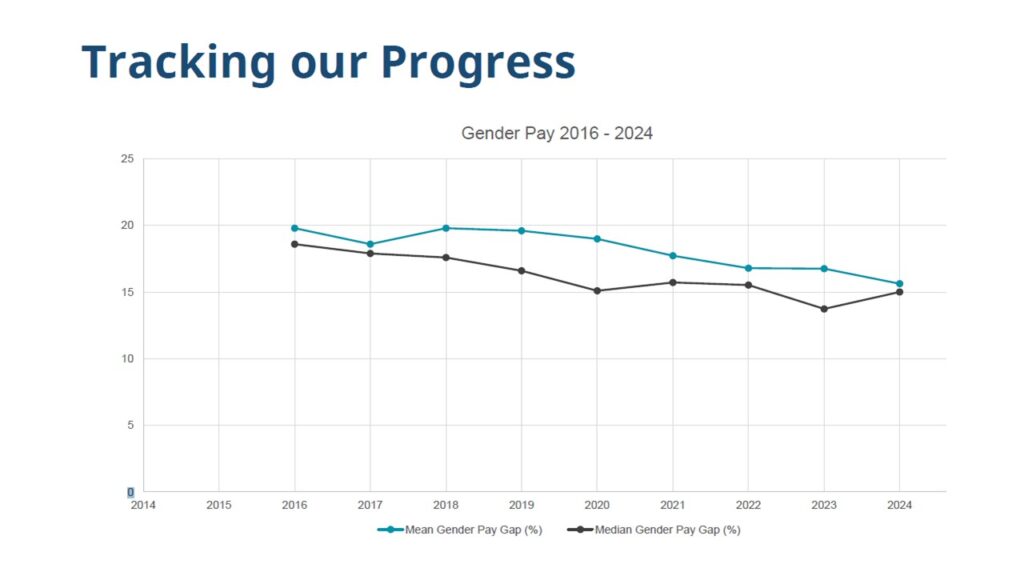Mandatory reporting of gender pay gap data was introduced in the UK in 2017 for organizations with more than 250 employees. The gender pay gap refers to the fact that across all jobs, considering hourly pay, women earn less than men. According to the Office for National Statistics, in 2024 the median hourly earnings for full-time employees, across all jobs in the UK, was 7% less for women than for men. This is not to be confused with the principles enshrined in the Equal Pay Act of 1970 which made it illegal to pay men and women different amounts to do the same job.
Abi Phillips (Deputy Director, Community & Inclusion) joined our most recent WACA Network event earlier this month to share her insights into the gender pay gap at Bath.
What is the gender pay gap at Bath? The University is required to report its data annually to the government and publishes these reports on our website. Employers must publish the following metrics:
- Mean and median hourly pay gap between men and women.
- Mean and median bonus pay gap between men and women.
- Proportion of men and women receiving bonuses.
- Proportion of men and women in each of the four pay quartiles.
At Bath we are making some progress with addressing the mean gender pay gap which was 19% in 2020, and 15.6% in 2024, although the median pay gap remains the same at 15%. This improvement, a reduction of 3.4% is in line with what other higher education providers have achieved (a reduction of 4.4% across HE sector in 2022) and the gender pay gap is narrower in the higher education sector than across the UK as a whole (Higher Education Policy Institute report).

The factors contributing to the gender pay gap are complex but analysis of the distribution of pay by grade shows that there are no significant, enduring differences of equal pay for equal work. It is the lower proportion of women in the more senior grades and lower proportion of men in the lower grades which contribute significantly to the difference in mean and median pay. We also know that more women than men choose to take up flexible working opportunities and that these are currently more common in the lower grades.
What actions is Bath taking to address the gender pay gap? A gender pay gap working group has been established at the University which meets annually to review the data at Bath and makes recommendations for actions to address the pay gap. Likely factors contributing to the reduction in the mean gender pay gap include an increasing proportion of women in academic roles (41.4% of academic staff are women), the proportion of professors that are women has increased, women professional services staff are taking on more senior roles and line management responsibilities. So overall, the gender pay gap is decreasing because we have increasing numbers of women at higher grades and therefore getting higher pay.
In 2025, work continues to address this persistent gender pay gap. For example, work to address unconscious bias in recruitment to ensure we continue to diversify the workforce and looking at processes in setting starting salaries for new staff. Women are less likely to negotiate higher starting salaries than men. New academic career progression criteria may encourage more women to come forward for promotion as they may more accurately reflect the totality of academic work. A further thread will look at steps to improve ‘exit data’, exploring the reasons people leave the University which may highlight that women are leaving for more senior roles, promotion and higher salaries elsewhere.
In her talk, Abi also highlighted that the University is now gathering data and reporting on pay gaps other than for Gender. Although not a statutory requirement, the University has committed to this as part of its Equality Objectives and is now reporting on pay gaps for ethnicity, disability and sexual orientation. This data is now published alongside the gender pay gap reports. Interestingly, in 2024, the mean disability pay gap was 19%, for sexual orientation 11% and for ethnicity 8%. There are still some challenges in ensuring the robustness of this data, depending on what individuals disclose, but this does enable a baseline to be set against which targeted actions can be evaluated in the future.
UK universities face a range of structural, cultural, and institutional challenges in addressing the gender pay gap. While many have made efforts to improve gender equality, the pay gap remains persistent and intersectional pay gaps are likely to be significant. Policies and actions that support women's career progression, such as mentorship and leadership development opportunities, can help them advance to higher-paying roles. Training in these areas to support the career development goals of women is something that the WACA network is continuing to press for and help close that pay gap.
Respond